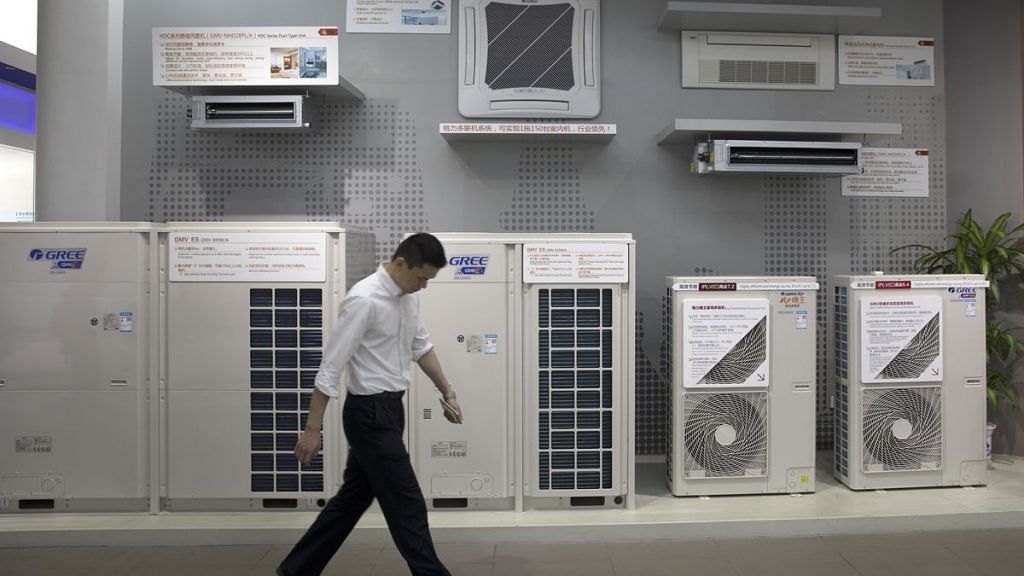New Delhi: As Indians get locked inside their homes for the next three weeks with summers driving up temperatures, an unlikely question has come up amid the pandemic — do air conditioners increase the risk of bringing coronavirus inside homes?
According to experts, home AC units do not pose any additional risk of Covid-19 infection, especially at a time when people are isolated inside their homes with no outside contact.
However, coronavirus can spread within spaces that are centrally air conditioned — such as shopping malls and some modern apartments, especially if an infected person is inside such spaces.
“This virus is not airborne in the same way as viruses that cause common cold and flu. It is just that if a person sneezes, a thick spray gets created — that is when a virus is in the air. But it does not float around in the air — it settles on surfaces and can stay there for a very long time,” explained Sambuddha Chaudhuri, an epidemiologist at the Indian Institute of Technology, Bombay.
“Since it does not stay suspended in the air for a very long time, air conditioners should not be a threat especially if it is in your own house where no one is infected,” he told ThePrint.
“Having said that, in places like centrally air-conditioned shopping centres etc, where there are usually a lot of people, the virus can get recycled in the air for a short span of time,” he warned.
In the wake of the pandemic, the Narendra Modi government has ordered people to stay away from crowded spaces as they can come in contact with someone infected.
If people visit a centrally air conditioned mall during a pandemic, the risk of getting exposed to the coronavirus directly from an infected person is far greater than getting it from the recycled AC air, Chaudhuri said.
Also read: How the coronavirus recession is like World War II
What studies say
While there is very little research on the effects of temperature on the virus, a 2011 study published in the journal Advances of Virology that looked at the transmission of SARS-CoV — another coronavirus that had emerged from China in 2003 — may throw some light.
The research showed that the virus was more stable at low temperature and low humidity environments, which could facilitate its transmission in air-conditioned environments.
Whether the same holds true for the SARS-CoV-2 is not yet well understood. Researchers at Purdue University in the US studied the air conditioning systems on the Diamond Princess — a 3,700-passenger cruise that was placed on lockdown off the coast of Yokohama after a passenger disembarked in Hong Kong and tested positive for the novel virus earlier this month.
According to a Centers for Disease Control and Prevention (CDC) report, 46.5 per cent of the passengers on board the Diamond Princess had infections at the time of testing. Traces of the SARS-CoV-2 was identified on a variety of surfaces in cabins of both symptomatic and asymptomatic passengers up to 17 days after cabins were vacated on the Diamond Princess.
According to Qingyan Chen, a researcher at Purdue University, said cruise ship air conditioning systems are not designed to filter out particles as small as the coronavirus, allowing the disease to rapidly circulate to other cabins.
“It’s standard practice for the air conditioning systems of cruise ships to mix outside air with inside air to save energy. The problem is that these systems can’t filter out particles smaller than 5,000 nanometers. If the coronavirus is about the same size as SARS, which is 120 nanometers in diameter, then the air conditioning system would be carrying the virus to every cabin,” Qingyan has said.
The same would hold true for air conditioning systems in flights.
Also read: Economic costs for India may be huge if COVID-19 fallout lasts 6 months: Arvind Panagariya
What to do at home
However, if a home uses split or window type of air conditioner, there would be no effect on coronavirus transmission, Qingyan told ThePrint.
“For a split type system, please open window a bit to have outdoor air entering room. For window air conditioning system, please increase the outdoor airflow rate if there is an option. If not, please open the window a bit to have more outside air,” he said.
“If one uses central air conditioning system, coronavirus could be transmitted to all the spaces it conditions if return air is used. For central air conditioning systems, I would recommend to use 100 per cent outside air,” he said.
The Federation of European Heating, Ventilation and Air Conditioning Associations (REHVA) has published guidelines on how building services in areas with a coronavirus outbreak should operate to minimise the spread of the infection.
The body recommends buildings to switch on ventilation systems round the clock, or at least extend the operation of ventilation systems as much as possible.
Ventilation rates should be switched to low power when people are absent in order to remove virus particles out of the building. Exhaust ventilation systems of toilets should be kept on 24/7, suggests REHVA. In buildings without mechanical ventilation systems, windows should be kept open for at least 15 minutes before somebody enters, especially if it was previously occupied by others.
However, such places should not keep windows in toilets open as it will encourage contaminated airflow from the toilet to other rooms.
Also read: Use hydroxychloroquine with caution: ICMR warns amid confusion over use of drug for Covid-19
